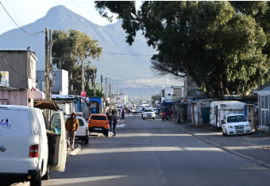
The City of Cape Town is calling on residents to comment on the draft Local Spatial Development Framework (LSDF) for Masiphumelele and the surrounding areas in the Far South.
The draft LSDF for Masiphumelele is available for public comment as from 15 August 2025, and interested parties can go to www.capetown.gov.za/haveyoursay to access the document and submit comments.
According to the city, the LSDF proposes a development vision and framework to manage
urban growth in a sustainable manner, taking into account current challenges such as the encroachment of the wetlands area; the dire need for housing opportunities and improved access routes; the lack of public open spaces and recreation areas; facilities provision, and local economic opportunities for residents.The LSDF takes into account the unique qualities and challenges of Masiphumelele, such as its location and future growth, local opportunities for economic development, and the need for formalising informal settlement areas that are currently located within the wetlands area, amongst others.
The city’s Deputy Mayor and Mayoral Committee Member for Spatial Planning and Environment, Eddie Andrews, noted that the relocation of informal settlements out of high-risk areas, and construction of a new road to improve access from Masiphumelele are key to the draft LSDF, including identifying possible land parcels in the area to support a range of housing opportunities.
“The draft spatial vision for the Masiphumelele area pursues a neighbourhood that is well integrated with the surrounding area, so that residents can have easy access to jobs and other opportunities, have more choices when it comes to residential opportunities, and for Masiphumelele to contribute to the local economy. It is a broad vision and must be sufficiently flexible to adapt to changing circumstances and needs,” Andrews said.
The closing date for comments is 21 October 2025. An information day is scheduled for Wednesday, 10 September, from 15:00 to 19:00 at the Living Hope Hall, no. 7 Kommetjie Road.
“At the information day, residents and stakeholders will be able to view the proposed LSDF, engage officials, and ask questions. I encourage residents to please attend and collaborate with the city on refining the LSDF, [because] once approved by council, this will be the spatial policy to map the way forward in terms of how we should address some key challenges and opportunities,” Andrews said.
Masiphumelele was established in 1992 with an initial 500 households and is now estimated to have a population of more than 38 000 people, with 90% of residents living in informal structures. There is a lack of proper access routes, housing, facilities and public open spaces.
The main objectives of the draft LSDF are as follows:
- To provide a development vision to guide and manage urban growth and broaden the choice of residential opportunities.
- To improve residents’ general living conditions.
- To balance competing land use demands and to implement a sustainable development path.
- To spatially integrate Masiphumelele with the surrounding areas through improved access routes, and walking and cycle lanes.
- To improve residents’ access to employment, local facilities and essential services.
“Importantly, there is a strong focus on improving the environmental conditions of the natural ecosystems such as the wetlands adjacent to Masiphumelele, and how this natural environment can enhance the quality of life and contribute to economic development,” Andrews said.
The draft LSDF identifies a number of challenges in Masiphumelele and seeks to address these. These include:
- Severe overcrowding, high densities, and a growing backlog in social facilities and services provision. The estimated future housing need, for example, equates to over 10 000 units.
- The limited public and private land available for development. The city owns about 25% of the land in Masiphumelele, most of which is wetlands, parks or intended for schools.
- The high risk of fire given the density and informal structures. Given the encroachment of the wetlands area, many structures are flood-prone.
- Informal settlements encroaching on the wetlands, and the subsequent solid waste and waste water pollution.
- The location of the wetlands settlement is a major obstacle to providing a much needed alternative road and access to Masiphumelele, with the planned extension of Houmoed Avenue.
- High unemployment.
- Congestion and limited access into and out of the area.
- Limited provision for informal economic sector activities.
- Limited public transport services, with households spending up to a third of their monthly income on commuting.
However, the draft LSDF also recognises a number of development opportunities in Masiphumelele, including:
- Its proximity to industrial areas, such as Lekker Water and Fish Eagle Park, can provide residents with easier access to jobs.
- A thriving informal economy can be improved and expanded.
- Access can be improved with the extension of Houmoed Avenue and by increasing the capacity of Kommetjie Road, and the addition of walk and cycle lanes.
“I encourage residents to please participate in this process. Ultimately, this plan belongs to the residents and will, once approved, determine Masiphumelele’s future development, the form and shape it will take, and residents’ quality of living.
"The spatial vision for Masiphumelele will also have an impact on surrounding communities, thus, the call for all in the area to take note of this process and to collaborate with us. We are eager to work with the community, other stakeholders and the surrounding neighbourhoods,” Andrews said. – SAnews.gov.za
No comments:
Post a Comment